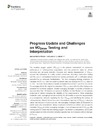Identificador persistente para citar o vincular este elemento:
https://accedacris.ulpgc.es/jspui/handle/10553/74890
| Título: | Progress Update and Challenges on VO2max Testing and Interpretation | Autores/as: | Martín Rincón, Marcos López Calbet, José Antonio |
Clasificación UNESCO: | 32 Ciencias médicas 320501 Cardiología |
Palabras clave: | Breath-By-Breath Calibration Cardiopulmonary Exercise Testing Indirect Calorimetry Metabolic Cart, et al. |
Fecha de publicación: | 2020 | Publicación seriada: | Frontiers in Physiology | Resumen: | © Copyright © 2020 Martin-Rincon and Calbet.The maximal oxygen uptake ((Formula presented.) O2max) is the primary determinant of endurance performance in heterogeneous populations and has predictive value for clinical outcomes and all-cause mortality. Accurate and precise measurement of (Formula presented.) O2max requires the adherence to quality control procedures, including combustion testing and the use of standardized incremental exercise protocols with a verification phase preceded by an adequate familiarization. The data averaging strategy employed to calculate the (Formula presented.) O2max from the breath-by-breath data can change the (Formula presented.) O2max value by 4–10%. The lower the number of breaths or smaller the number of seconds included in the averaging block, the higher the calculated (Formula presented.) O2max value with this effect being more prominent in untrained subjects. Smaller averaging strategies in number of breaths or seconds (less than 30 breaths or seconds) facilitate the identification of the plateau phenomenon without reducing the reliability of the measurements. When employing metabolic carts, averaging intervals including 15–20 breaths or seconds are preferable as a compromise between capturing the true (Formula presented.) O2max and identifying the plateau. In training studies, clinical interventions and meta-analysis, reporting of (Formula presented.) O2max in absolute values and inclusion of protocols and the averaging strategies arise as imperative to permit adequate comparisons. Newly developed correction equations can be used to normalize (Formula presented.) O2max to similar averaging strategies. A lack of improvement of (Formula presented.) O2max with training does not mean that the training program has elicited no adaptations, since peak cardiac output and mitochondrial oxidative capacity may be increased without changes in (Formula presented.) O2max. | URI: | https://accedacris.ulpgc.es/handle/10553/74890 | ISSN: | 1664-042X | DOI: | 10.3389/fphys.2020.01070 | Fuente: | Frontiers in Physiology [EISSN 1664-042X], v. 11, (Septiembre 2020) |
| Colección: | Reseña |
Citas SCOPUSTM
34
actualizado el 08-jun-2025
Citas de WEB OF SCIENCETM
Citations
29
actualizado el 08-jun-2025
Visitas
120
actualizado el 23-nov-2024
Descargas
255
actualizado el 23-nov-2024
Google ScholarTM
Verifica
Altmetric
Comparte
Exporta metadatos
Los elementos en ULPGC accedaCRIS están protegidos por derechos de autor con todos los derechos reservados, a menos que se indique lo contrario.
